Rheology of Suspensions of TEMPO-Oxidised and Cationic Cellulose Nanofibrils—The Effect of Chemical Pre-Treatment
Abstract
1. Introduction
2. Results and Discussion
3. Conclusions
4. Materials and Methods
4.1. Materials
4.2. Chemical Modification (Pre-Treatment) and Preparation of Nanofibres
4.3. Characterization of the Obtained Cellulose Nanofibres
4.4. Rheology of CNF Suspensions
4.4.1. Preparation of Nanofibre Suspensions
4.4.2. Rheology of the Suspensions
Supplementary Materials
Author Contributions
Funding
Informed Consent Statement
Data Availability Statement
Conflicts of Interest
References
- Djafari Petroudy, S.R.; Chabot, B.; Loranger, E.; Naebe, M.; Shojaeiarani, J.; Gharehkhani, S.; Ahvazi, B.; Hu, J.; Thomas, S. Recent Advances in Cellulose Nanofibers Preparation through Energy-Efficient Approaches: A Review. Energies 2021, 14, 6792. [Google Scholar] [CrossRef]
- Surendran, G.; Sherje, A.P. Cellulose nanofibers and composites: An insight into basics and biomedical applications. J. Drug Deliv. Sci. Technol. 2022, 75, 103601. [Google Scholar] [CrossRef]
- Alves, L.; Ramos, A.; Rasteiro, M.G.; Vitorino, C.; Ferraz, E.; Ferreira, P.J.T.; Puertas, M.L.; Gamelas, J.A.F. Composite Films of Nanofibrillated Cellulose with Sepiolite: Effect of Preparation Strategy. Coatings 2022, 12, 303. [Google Scholar] [CrossRef]
- Jeencham, R.; Le, H.M.; Numpaisal, P.-O.; Ruksakulpiwat, Y. Preparation of cellulose nanofiber from cassava pulp by high-pressure homogenizer. In Proceedings of the 37th International Conference of the Polymer Processing Society (PPS-37), Fukuoka City, Japan, 11–15 April 2022; AIP Publishing LLC.: College Park, MA, USA, 2023; Volume 2884. [Google Scholar] [CrossRef]
- Nechyporchuk, O.; Belgacem, M.N.; Bras, J. Production of cellulose nanofibrils: A review of recent advances. Ind. Crops Prod. 2016, 93, 2–25. [Google Scholar] [CrossRef]
- Jowkarderis, L.; van de Ven, T.G.M. Rheology of semi-dilute suspensions of carboxylated cellulose nanofibrils. Carbohydr. Polym. 2015, 123, 416–423. [Google Scholar] [CrossRef]
- Turbak, A.F.; Snyder, F.W.; Sandberg, K.R. Microfibrillated Cellulose, a New Cellulose Product: Properties, Uses, and Commercial Potential; ITT Rayonier Inc.: Shelton, WA, USA, 1983; pp. 815–827. [Google Scholar]
- Pedrosa, J.F.S.; Rasteiro, M.G.; Neto, C.P.; Ferreira, P.J.T. Effect of cationization pretreatment on the properties of cationic Eucalyptus micro/nanofibrillated cellulose. Int. J. Biol. Macromol. 2022, 201, 468–479. [Google Scholar] [CrossRef]
- Tavakolian, M.; Jafari, S.M.; van de Ven, T.G.M. A Review on Surface-Functionalized Cellulosic Nanostructures as Biocompatible Antibacterial Materials. Nano-Micro Lett. 2020, 12, 73. [Google Scholar] [CrossRef] [PubMed]
- Ribau Teixeira, M.; Ismail, A.; Medronho, B.; Alves, L.; Pedrosa, J.F.S.; Ferreira, P.J.T.; Serrão Sousa, V.; Rosa da Costa, A.M. Nanofibrillated cationic cellulose derivatives as flocculants for domestic wastewater treatment. J. Water Process Eng. 2024, 58, 104817. [Google Scholar] [CrossRef]
- Song, Y.; Sun, Y.; Zhang, X.; Zhou, J.; Zhang, L. Homogeneous Quaternization of Cellulose in NaOH/Urea Aqueous Solutions as Gene Carriers. Biomacromolecules 2008, 9, 2259–2264. [Google Scholar] [CrossRef]
- Alves, L.; Lindman, B.; Klotz, B.; Böttcher, A.; Haake, H.-M.; Antunes, F.E. Rheology of polyacrylate systems depends strongly on architecture. Colloid Polym. Sci. 2015, 293, 3285–3293. [Google Scholar] [CrossRef]
- Alves, L.; Ferraz, E.; Lourenço, A.F.; Ferreira, P.J.T.; Rasteiro, M.G.; Gamelas, J.A.F. Tuning rheology and aggregation behaviour of TEMPO-oxidised cellulose nanofibrils aqueous suspensions by addition of different acids. Carbohydr. Polym. 2020, 237, 116109. [Google Scholar] [CrossRef] [PubMed]
- Nechyporchuk, O.; Belgacem, M.N.; Pignon, F. Current Progress in Rheology of Cellulose Nanofibril Suspensions. Biomacromolecules 2016, 17, 2311–2320. [Google Scholar] [CrossRef] [PubMed]
- Hubbe, M.A.; Tayeb, P.; Joyce, M.; Tyagi, P.; Kehoe, M.; Dimic-Misic, K.; Pal, L. Rheology of Nanocellulose-rich Aqueous Suspensions: A Review. BioResources 2017, 12, 9556–9661. [Google Scholar] [CrossRef]
- Sato, Y.; Kusaka, Y.; Kobayashi, M. Charging and Aggregation Behavior of Cellulose Nanofibers in Aqueous Solution. Langmuir 2017, 33, 12660–12669. [Google Scholar] [CrossRef] [PubMed]
- Fukuzumi, H.; Tanaka, R.; Saito, T.; Isogai, A. Dispersion stability and aggregation behavior of TEMPO-oxidized cellulose nanofibrils in water as a function of salt addition. Cellulose 2014, 21, 1553–1559. [Google Scholar] [CrossRef]
- Šebenik, U.; Krajnc, M.; Alič, B.; Lapasin, R. Ageing of aqueous TEMPO-oxidized nanofibrillated cellulose dispersions: A rheological study. Cellulose 2019, 26, 917–931. [Google Scholar] [CrossRef]
- Calabrese, V.; Muñoz-García, J.C.; Schmitt, J.; da Silva, M.A.; Scott, J.L.; Angulo, J.; Khimyak, Y.Z.; Edler, K.J. Understanding heat driven gelation of anionic cellulose nanofibrils: Combining saturation transfer difference (STD) NMR, small angle X-ray scattering (SAXS) and rheology. J. Colloid Interface Sci. 2019, 535, 205–213. [Google Scholar] [CrossRef]
- Da Silva, M.A.; Calabrese, V.; Schmitt, J.; Celebi, D.; Scott, J.L.; Edler, K.J. Alcohol induced gelation of TEMPO-oxidized cellulose nanofibril dispersions. Soft Matter 2018, 14, 9243–9249. [Google Scholar] [CrossRef]
- Quennouz, N.; Hashmi, S.M.; Choi, H.S.; Kim, J.W.; Osuji, C.O. Rheology of cellulose nanofibrils in the presence of surfactants. Soft Matter 2016, 12, 157–164. [Google Scholar] [CrossRef]
- Kopač, T.; Krajnc, M.; Ručigaj, A. A rheological study of cationic micro- and nanofibrillated cellulose: Quaternization reaction optimization and fibril characteristic effects. Cellulose 2022, 29, 1435–1450. [Google Scholar] [CrossRef]
- Moberg, T.; Sahlin, K.; Yao, K.; Geng, S.; Westman, G.; Zhou, Q.; Oksman, K.; Rigdahl, M. Rheological properties of nanocellulose suspensions: Effects of fibril/particle dimensions and surface characteristics. Cellulose 2017, 24, 2499–2510. [Google Scholar] [CrossRef]
- Alves, L.; Ramos, A.; Ferraz, E.; Ferreira, P.J.T.; Rasteiro, M.G.; Gamelas, J.A.F. Design of cellulose nanofibre-based composites with high barrier properties. Cellulose 2023, 30, 10157–10174. [Google Scholar] [CrossRef]
- Kronberg, B.; Holmberg, K.; Lindman, B. Polymers in Solution. In Surface Chemistry of Surfactants and Polymers; John Wiley & Sons: Hoboken, NJ, USA, 2014; pp. 175–195. [Google Scholar] [CrossRef]
- Gorbacheva, S.N.; Ilyin, S.O. Morphology and Rheology of Heavy Crude Oil/Water Emulsions Stabilized by Microfibrillated Cellulose. Energy Fuels 2021, 35, 6527–6540. [Google Scholar] [CrossRef]
- Molinari, G.; Gigante, V.; Fiori, S.; Aliotta, L.; Lazzeri, A. Dispersion of Micro Fibrillated Cellulose (MFC) in Poly(lactic acid) (PLA) from Lab-Scale to Semi-Industrial Processing Using Biobased Plasticizers as Dispersing Aids. Chemistry 2021, 3, 896–915. [Google Scholar] [CrossRef]
- Pääkkönen, T.; Dimic-Misic, K.; Orelma, H.; Pönni, R.; Vuorinen, T.; Maloney, T. Effect of xylan in hardwood pulp on the reaction rate of TEMPO-mediated oxidation and the rheology of the final nanofibrillated cellulose gel. Cellulose 2016, 23, 277–293. [Google Scholar] [CrossRef]
- Wågberg, L.; Decher, G.; Norgren, M.; Lindström, T.; Ankerfors, M.; Axnäs, K. The Build-Up of Polyelectrolyte Multilayers of Microfibrillated Cellulose and Cationic Polyelectrolytes. Langmuir 2008, 24, 784–795. [Google Scholar] [CrossRef] [PubMed]
- Pedrosa, J.F.S.; Alves, L.; Neto, C.P.; Rasteiro, M.G.; Ferreira, P.J.T. Assessment of the Performance of Cationic Cellulose Derivatives as Calcium Carbonate Flocculant for Papermaking. Polymers 2022, 14, 3309. [Google Scholar] [CrossRef]
- Henriques, P.; Martinho, M.; Serrano, M.d.L.; Mendes de Sousa, A.P.; Brites Alves, A.M. Xylooligosaccharides production by acid hydrolysis of an alkaline extraction filtrate from Eucalyptus globulus bleached kraft pulp. Ind. Crops Prod. 2021, 159, 113066. [Google Scholar] [CrossRef]
- Saito, T.; Kimura, S.; Nishiyama, Y.; Isogai, A. Cellulose Nanofibers Prepared by TEMPO-Mediated Oxidation of Native Cellulose. Biomacromolecules 2007, 8, 2485–2491. [Google Scholar] [CrossRef]
- Grenda, K.; Arnold, J.; Gamelas, J.A.F.; Rasteiro, M.G. Environmentally friendly cellulose-based polyelectrolytes in wastewater treatment. Water Sci. Technol. 2017, 76, 1490–1499. [Google Scholar] [CrossRef]
- Kristiansen, K.A.; Potthast, A.; Christensen, B.E. Periodate oxidation of polysaccharides for modification of chemical and physical properties. Carbohydr. Res. 2010, 345, 1264–1271. [Google Scholar] [CrossRef] [PubMed]
- Wei, J.; Du, C.; Liu, H.; Chen, Y.; Yu, H.; Zhou, Z. Preparation and Characterization of Aldehyde-Functionalized Cellulosic Fibers through Periodate Oxidization of Bamboo Pulp. BioResources 2016, 11, 8386–8395. [Google Scholar] [CrossRef]
- Henriksson, M.; Berglund, L.A.; Isaksson, P.; Lindström, T.; Nishino, T. Cellulose Nanopaper Structures of High Toughness. Biomacromolecules 2008, 9, 1579–1585. [Google Scholar] [CrossRef] [PubMed]
- Shunkevich, A.A.; Akulich, Z.I.; Mediak, G.V.; Soldatov, V.S. Acid–base properties of ion exchangers. III. Anion exchangers on the basis of polyacrylonitrile fiber. React. Funct. Polym. 2005, 63, 27–34. [Google Scholar] [CrossRef]
- Hiroshi, M. Rheology—Theory and Application to Biomaterials. In Polymerization; Ailton De Souza, G., Ed.; IntechOpen: Rijeka, Croatia, 2012; p. 17. [Google Scholar] [CrossRef]
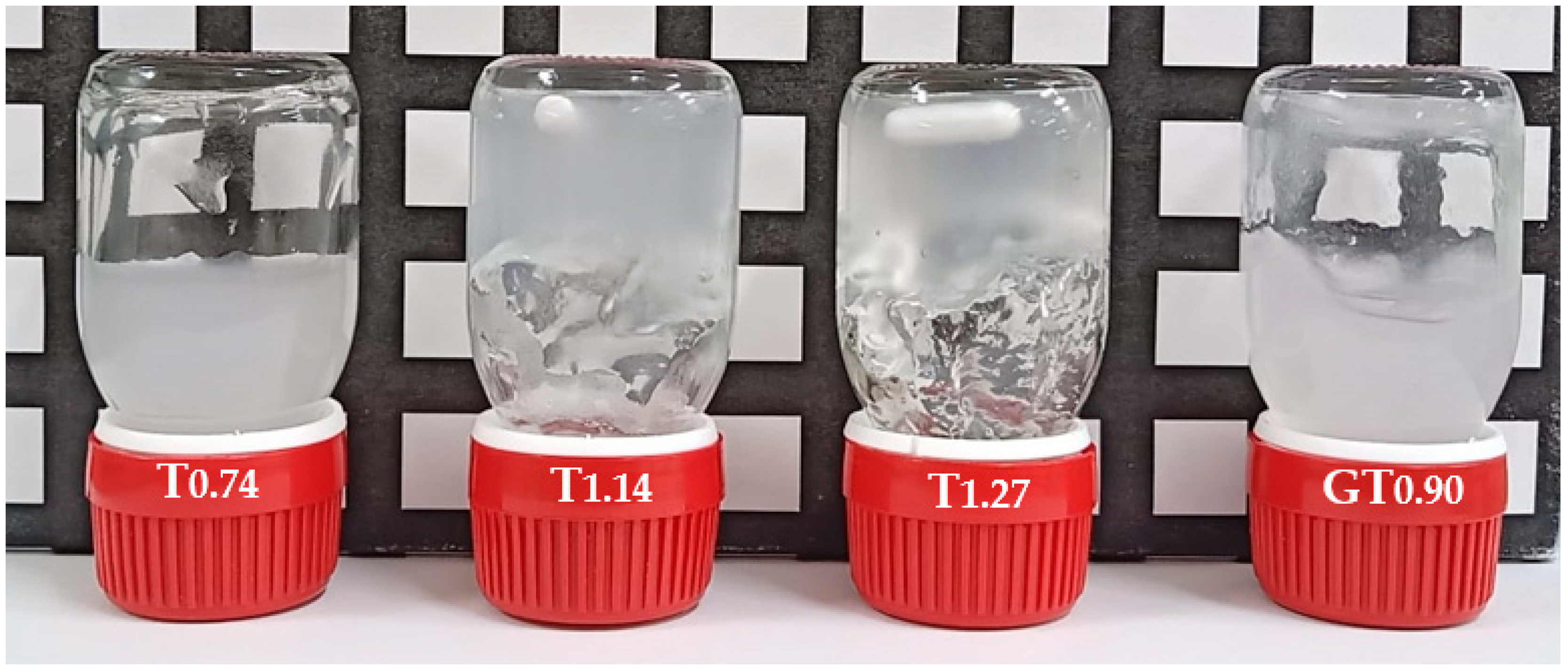
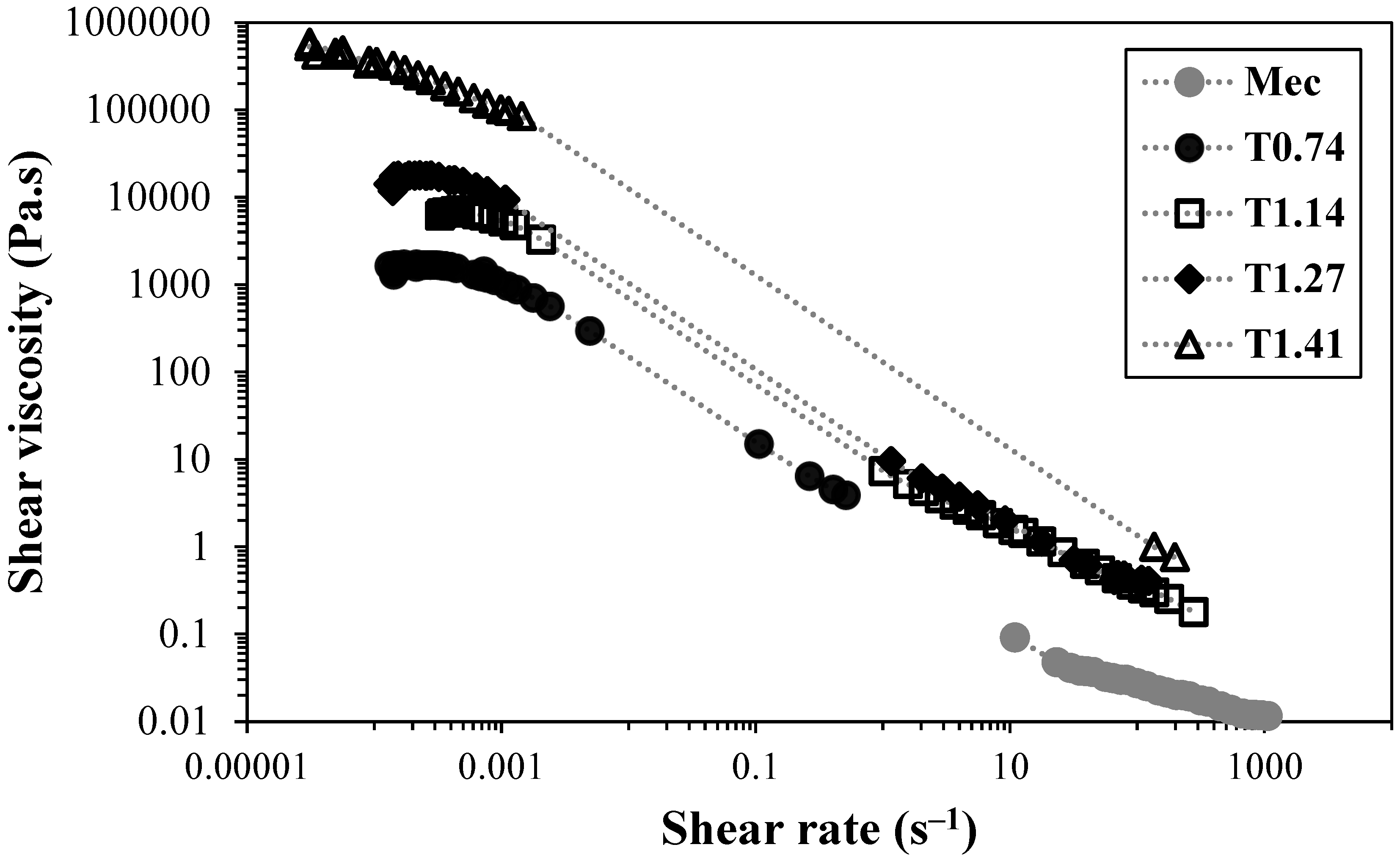
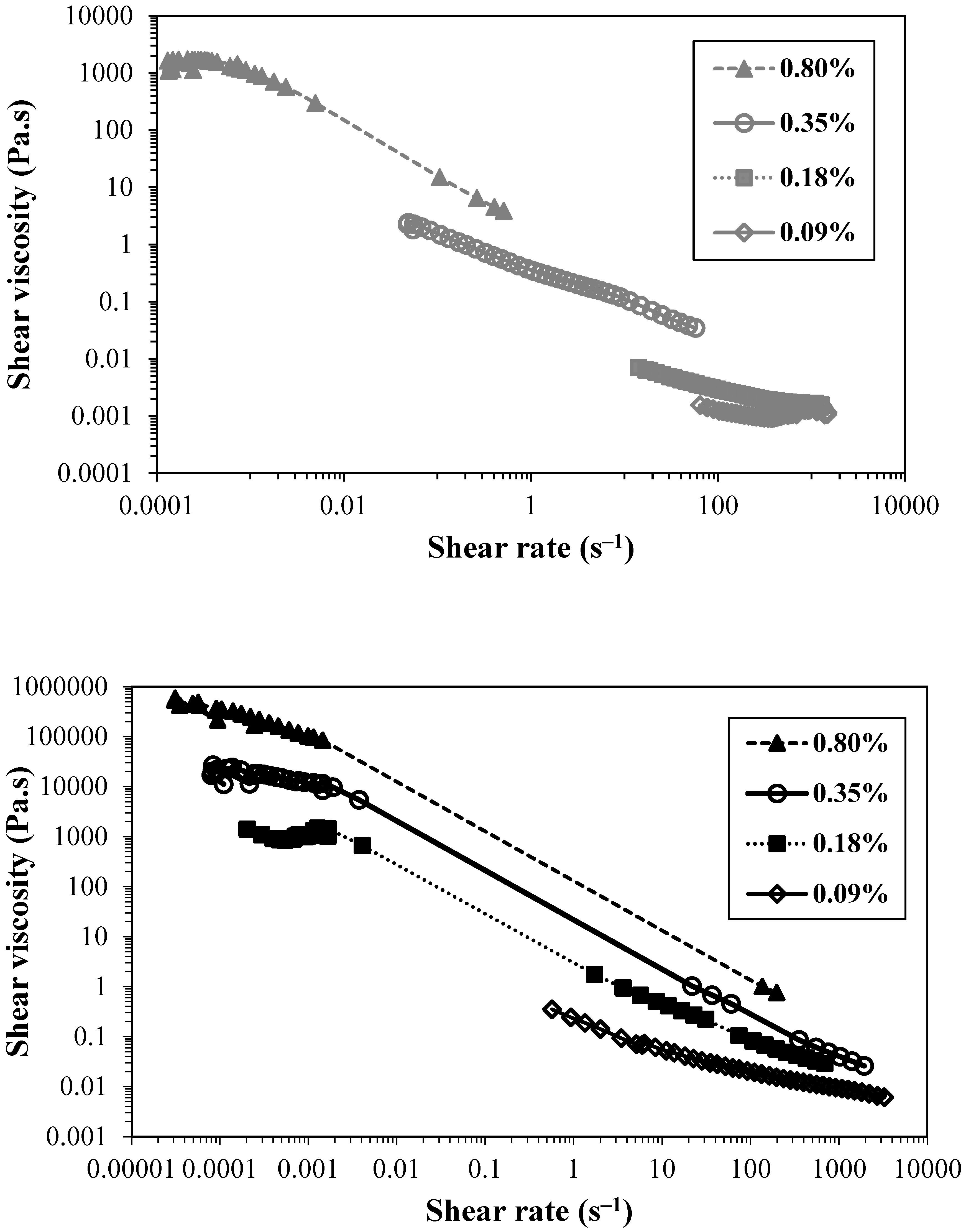

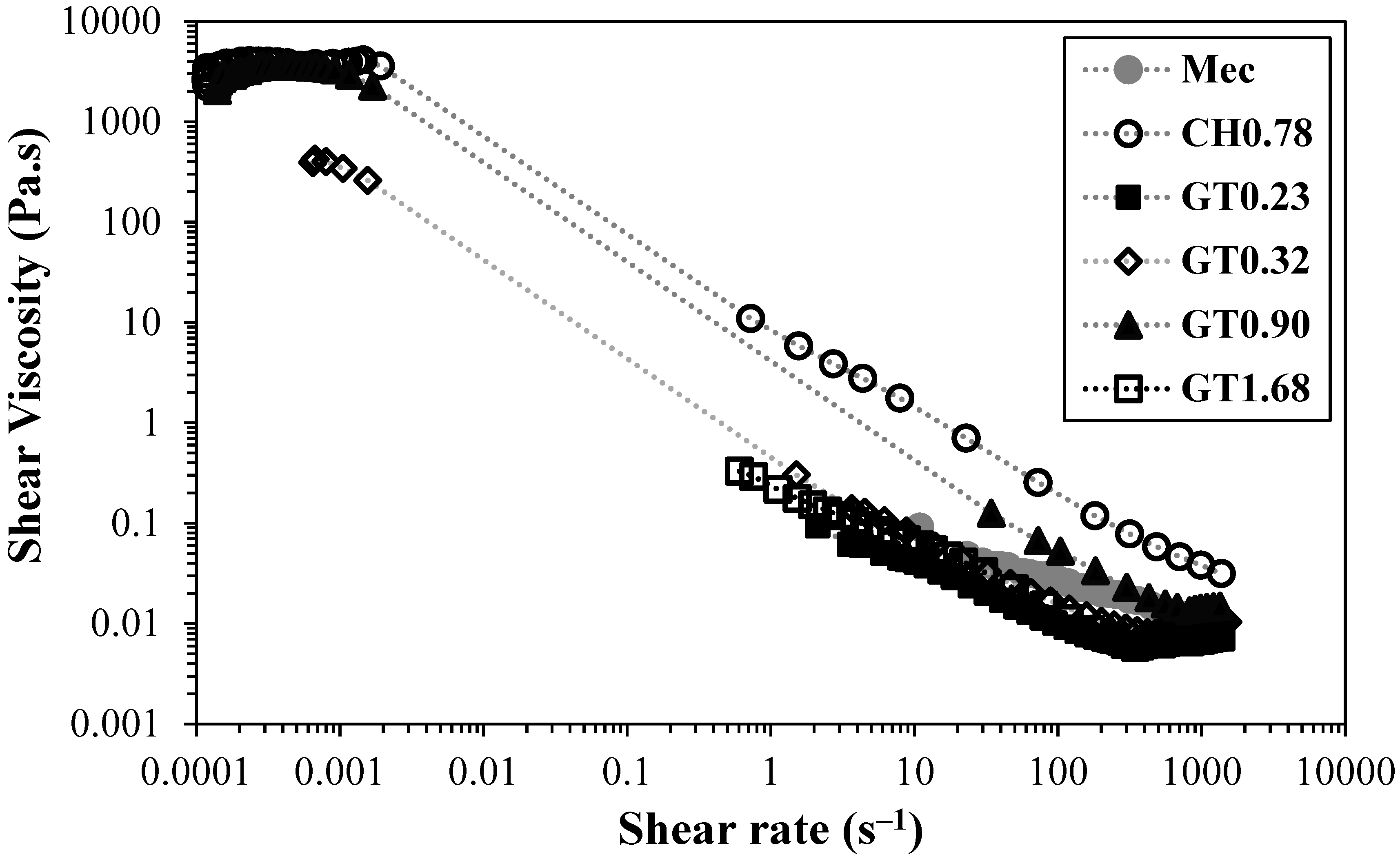
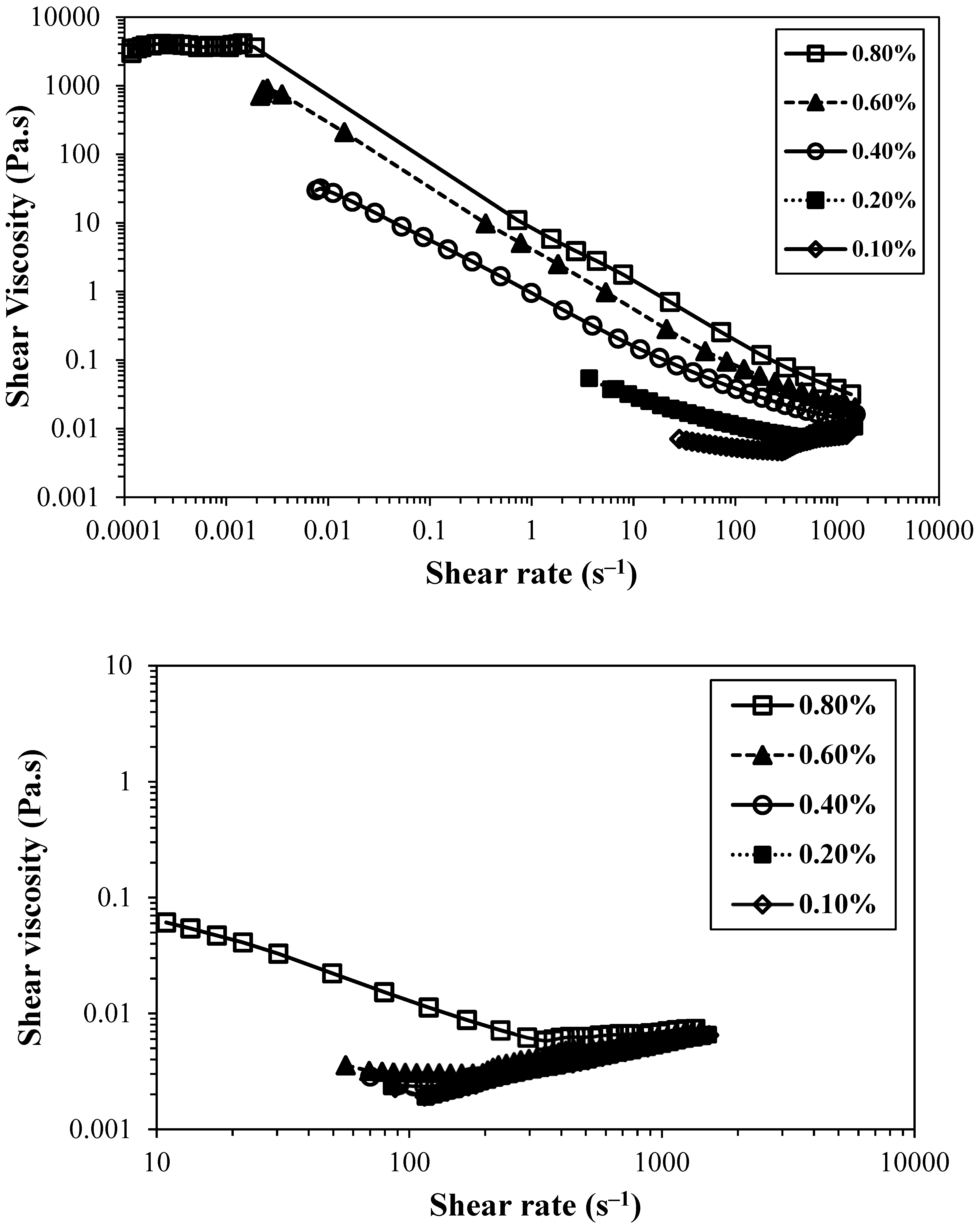
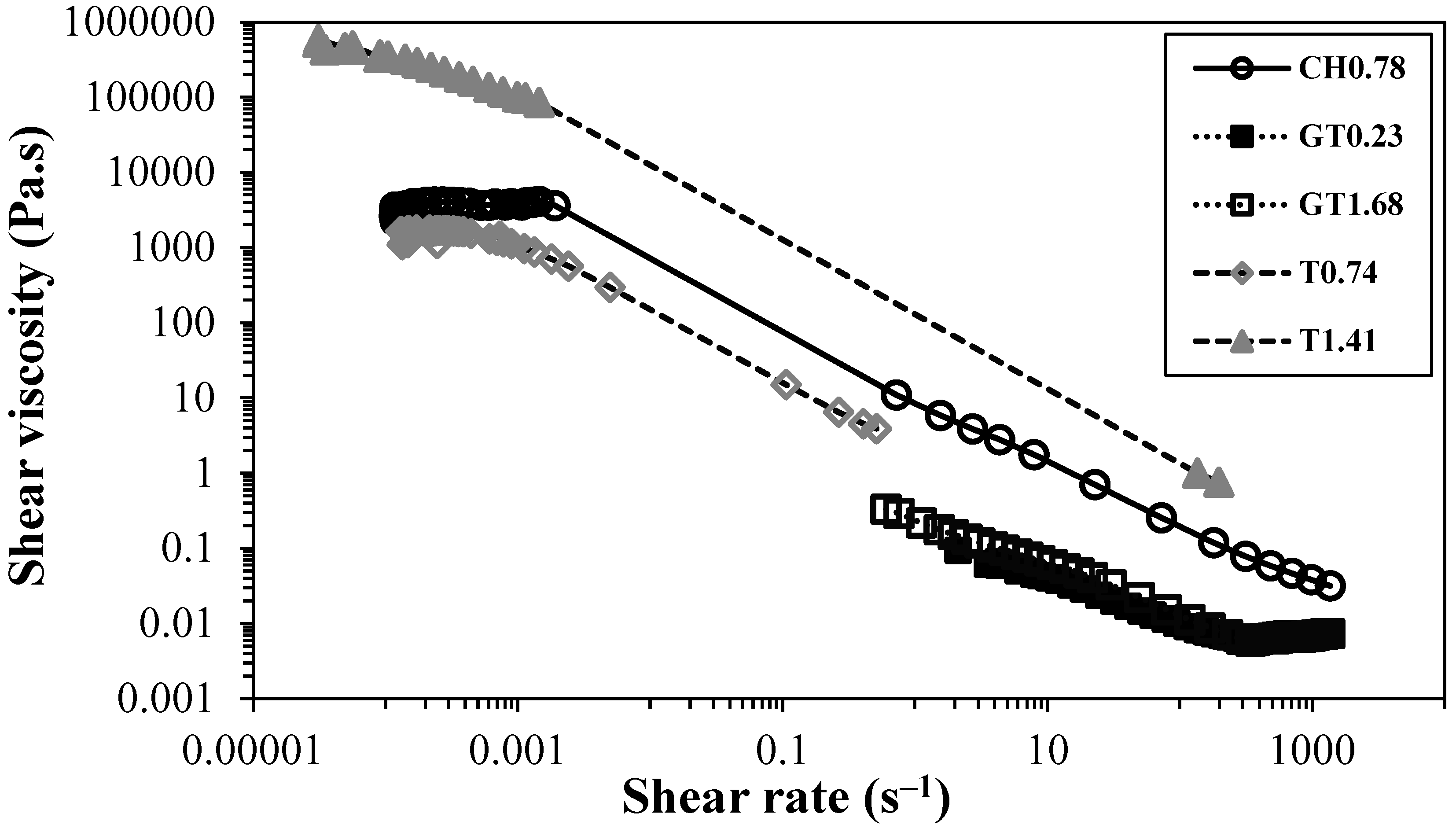
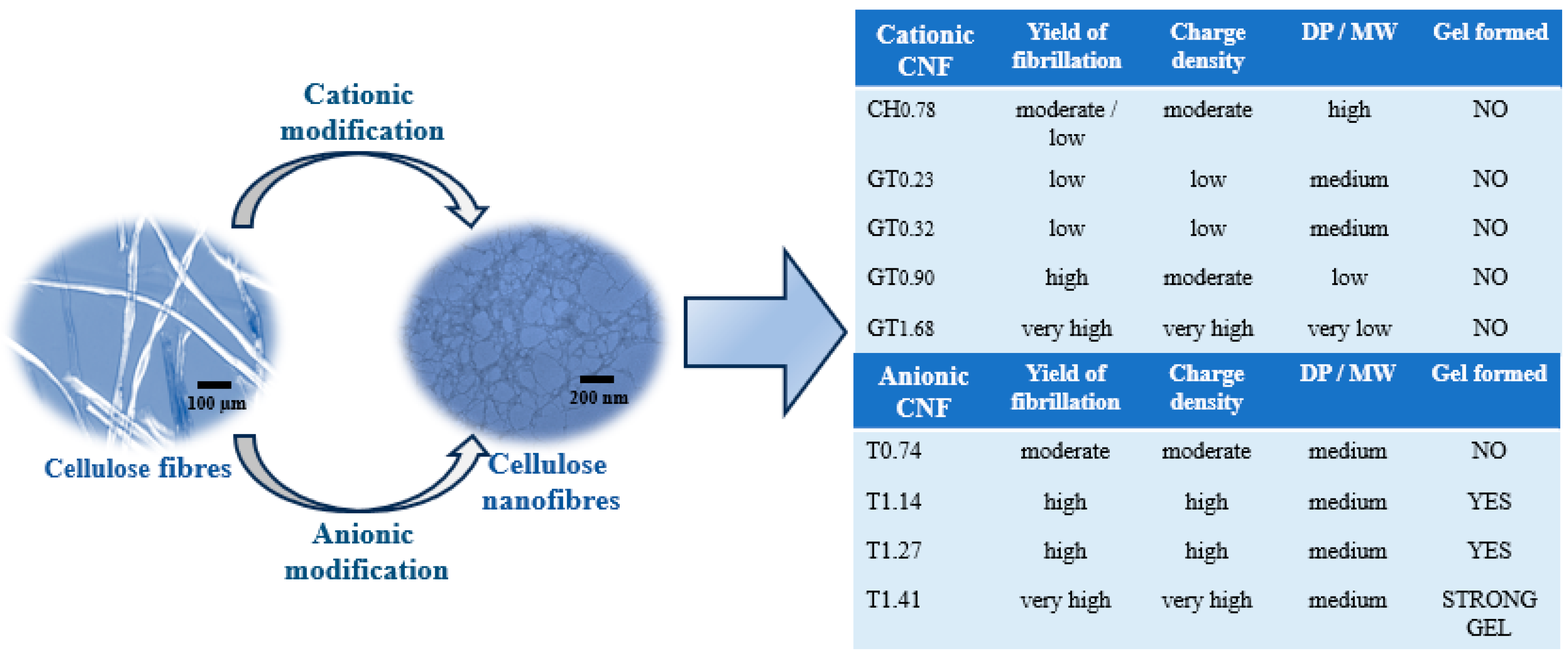
| CNF | Charge Density (mmol/g) | Degree of Fibrillation (%) | Intrinsic Viscosity (mL/g) | Degree of Polymerization | Zeta Potential (mV) | Hydrodynamic Radius (nm) |
|---|---|---|---|---|---|---|
| Mec | 0.12 | 6.5 | 815 | 2287 | −14 ± 4 | 861 ± 151 |
| CH0.78 | 0.78 | 29.0 | 965 | 2859 | +26 ± 3 | --- |
| GT0.23 | 0.23 | 6.0 | 183 | 437 | +24 ± 2 | --- |
| GT0.32 | 0.32 | 12.0 | 102 | 244 | +29 ± 5 | --- |
| GT0.90 | 0.90 | 98.0 | 20 | 47 | +27 ± 2 | 147 ± 4 |
| GT1.68 | 1.68 | 100.0 | 11 | 26 | +30 ± 3 | 106 ± 15 |
| T0.74 | 0.74 | 49.3 | 160 | 381 | −42 ± 10 | 381 ± 19 |
| T1.14 | 1.14 | 65.5 | 143 | 340 | −46 ± 4 | 479 ± 40 |
| T1.27 | 1.27 | 88.1 | 150 | 355 | −49 ± 6 | 317 ± 21 |
| T1.41 | 1.41 | 100.0 | 153 | 365 | −82 ± 10 | 161 ± 14 |
| Sample | k (Pa·sn) | n | r | C.S.R. (s−1) | c* (wt.%) |
|---|---|---|---|---|---|
| T0.74 | 0.897 | 0.409 | 0.997 | 6.0 × 10−4 | 0.18–0.35 |
| T1.14 | 7.241 | 0.340 | 0.999 | 9.0 × 10−4 | ---- |
| T1.27 | 796.2 | 0.624 | 0.997 | 5.0 × 10−4 | ---- |
| T1.41 | 2136 | 0.440 | 0.987 | 3.0 × 10−4 | 0.09–0.18 |
| T0.74 (1) | 0.380 | 0.404 | 0.996 | 5.0 × 10−2 | ---- |
| T0.74 (2) | 0.025 | 0.763 | 0.994 | ---- | ---- |
| T0.74 (3) | 0.019 | 0.607 | 0.993 | ---- | ---- |
| T1.41 (1) | 911.6 | 0.632 | 0.993 | 1.0 × 10−3 | ---- |
| T1.41 (2) | 94.39 | 0.616 | 0.973 | 2.0 × 10−3 | ---- |
| T1.41 (3) | 0.235 | 0.361 | 0.995 | ---- | ---- |
| T0.74 (1.1) | 385.5 | 0.595 | 0.994 | 3.0 × 10−4 | ---- |
| T1.41 (1.2) | 144.0 | 0.310 | 0.998 | 2.0 × 10−5 | ---- |
| CH0.78 | 839.6 | 0.733 | 0.992 | 1.8 × 10−3 | 0.13 |
| GT0.23 | 0.171 | 0.402 | 0.998 | ---- | 0.40 |
| GT0.32 | 12.12 | 0.503 | 0.999 | 8.0 × 10−4 | 0.42 |
| GT0.90 | 95.75 | 0.615 | 0.994 | 1.9 × 10−3 | 0.32 |
| GT1.68 | 0.241 | 0.390 | 0.999 | ---- | 0.60 |
| CH0.78 (4) | 25.16 | 0.360 | 1.000 | 3.5 × 10−3 | ---- |
| CH0.78 (5) | 0.651 | 0.298 | 1.000 | 9.0 × 10−3 | ---- |
| CH0.78 (6) | 0.061 | 0.625 | 0.997 | ---- | ---- |
| CH0.78 (7) | 0.015 | 0.768 | 0.992 | ---- | ---- |
| GT1.68 (4) | 0.005 | 0.998 | 0.957 | ---- | ---- |
| GT1.68 (5) | 0.004 | 1.170 | 0.970 | ---- | ---- |
| GT1.68 (6) | 0.003 | 1.027 | 0.955 | ---- | ---- |
| GT1.68 (7) | 0.002 | 1.048 | 0.967 | ---- | ---- |
Disclaimer/Publisher’s Note: The statements, opinions and data contained in all publications are solely those of the individual author(s) and contributor(s) and not of MDPI and/or the editor(s). MDPI and/or the editor(s) disclaim responsibility for any injury to people or property resulting from any ideas, methods, instructions or products referred to in the content. |
© 2024 by the authors. Licensee MDPI, Basel, Switzerland. This article is an open access article distributed under the terms and conditions of the Creative Commons Attribution (CC BY) license (https://creativecommons.org/licenses/by/4.0/).
Share and Cite
Alves, L.; Magalhães, S.; Pedrosa, J.F.S.; Ferreira, P.J.T.; Gamelas, J.A.F.; Rasteiro, M.G. Rheology of Suspensions of TEMPO-Oxidised and Cationic Cellulose Nanofibrils—The Effect of Chemical Pre-Treatment. Gels 2024, 10, 367. https://doi.org/10.3390/gels10060367
Alves L, Magalhães S, Pedrosa JFS, Ferreira PJT, Gamelas JAF, Rasteiro MG. Rheology of Suspensions of TEMPO-Oxidised and Cationic Cellulose Nanofibrils—The Effect of Chemical Pre-Treatment. Gels. 2024; 10(6):367. https://doi.org/10.3390/gels10060367
Chicago/Turabian StyleAlves, Luís, Solange Magalhães, Jorge F. S. Pedrosa, Paulo J. T. Ferreira, José A. F. Gamelas, and Maria Graça Rasteiro. 2024. "Rheology of Suspensions of TEMPO-Oxidised and Cationic Cellulose Nanofibrils—The Effect of Chemical Pre-Treatment" Gels 10, no. 6: 367. https://doi.org/10.3390/gels10060367
APA StyleAlves, L., Magalhães, S., Pedrosa, J. F. S., Ferreira, P. J. T., Gamelas, J. A. F., & Rasteiro, M. G. (2024). Rheology of Suspensions of TEMPO-Oxidised and Cationic Cellulose Nanofibrils—The Effect of Chemical Pre-Treatment. Gels, 10(6), 367. https://doi.org/10.3390/gels10060367










